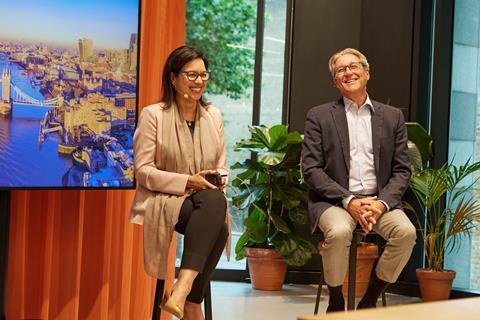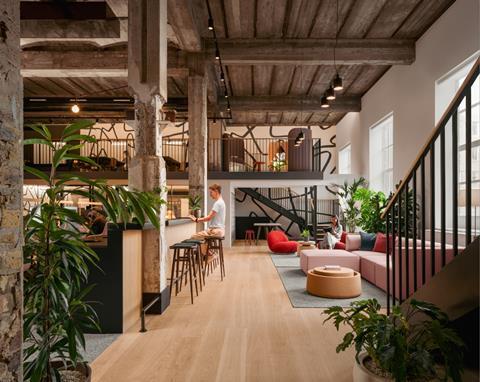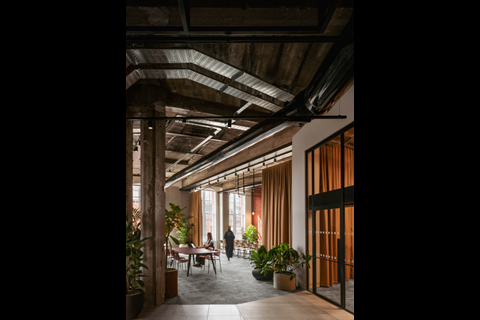The co-chair of the world’s largest architecture practice tells Tom Lowe about the firm’s journey over the past few turbulent years and why they decided to write a survival guide for architects

“Gensler is an entirely ‘we’ based organisation. It’s not about ‘I’. It’s not about ego.”
In a profession notoriously full of egos, this is an unexpected thing to hear from the co-chair of a practice which raked in $1.84bn (£1.46bn) last year. But Gensler, Diane Hoskins says, is not like other architects.
Explaining the secret to the firm’s success, she adds: “We’re not a pyramid. We’re not a practice that is focused on one person’s vision or one person’s talent.”
US-based Gensler is by far the biggest architectural firm in the world, topping BD’s WA100 ranking of the globe’s 100 largest practices in January for the eighth consecutive year. The first to break the 3,000 barrier for its number of staff, it now employs more than 1,000 more people than Arcadis, the next biggest on the list, which came in with a relatively paltry headcount of 1,956.
It does not really get bigger than this in terms of architecture interviews and, while there may be no pyramid at Gensler, as global co-chair Hoskins sits right at the top. She is talking to BD now because the practice has just published a new book on its business and design strategy, which for architects wondering how to grow their firm to global domination levels could be quite a helpful manual.
The heft of Gensler was made clear when Hoskins’ team asked for a list of questions in advance so that they could be vetted – and then sent them back with several removed. She led the firm for nearly 20 years as co-chief executive in partnership with Andy Cohen before the pair were promoted to the new position of co-chair on 1 January and succeeded by two new co-chief executives, Julia Simet and Jordan Goldstein.
It is normal to have one PR sit in during an interview with a senior person of a large organisation; Hoskins has two during the video call. For a firm without ego, it is still keenly aware of its size and impact in the profession.
We talk about Gensler’s success and, if you ask any person in the firm, they would say it’s the culture
Diane Hoskins, global co-chair
So how did Gensler get so big in the first place? Hoskins boils it down to two factors.
“There are things that I believe are very unique to Gensler’s approach,” she says, speaking from her office in Washington DC, one of the firm’s two headquarters. “We talk about Gensler’s success and, if you ask any person in the firm, they would say it’s the culture.”
Hoskins is a native of Chicago and previously worked for SOM, which is based in the city, before joining Gensler in 1994. She also worked for Olympia & York, the developer that spearheaded the construction of Canary Wharf in the 1980s before going bankrupt in 1993. The thing that makes Gensler different, she suggests, is the spirit of cooperation between its staff.
This is central to everything that Gensler does. It is why it has two chief executives and two US headquarters – the other being in San Francisco, where Cohen is based. When the pair’s new appointments were announced in October it was also revealed that Simet, one of the co-chief executives, woud be based in London to increase the global reach.
There is no design genius at the top who dominates Gensler’s creative direction, but collaboration of “broad talent” and a belief in “diversity of ideas” that come together in what the company calls its “one-firm firm” culture, an American term for a management strategy that aims to foster trust and loyalty among staff towards the wider organisation and to each other.

“It’s really a commitment to collaboration that is phenomenal,” Hoskins explains. “And I say this because I’ve worked at a couple of other firms. You know, you can ask a question of anyone at Gensler, they will drop everything and make sure that you get your answer or that they put you in touch with the person who will best be able to bring the content that you’re looking for.”
The second key to the firm’s success, she says, is the level of service it offers to clients. What holds many practices back is insufficient depth of engagement with the needs of clients, Hoskins suggests.
While most practices would class themselves as generalists, including Gensler, she believes that what sets her firm apart is a level of expertise in diverse fields that is highly valued by clients and enables the practice to pitch design solutions which the client may not have thought of.
You shouldn’t come to the table with that blank sheet of paper and say, ‘what do you need’, but really be able to engage at a very sophisticated level
Diane Hoskins
“Our philosophy, our core, is a real partnership with our clients,” Hoskins says. “There are many firms that will look at the client as a kind of necessary factor, but not necessarily a part of how we create great work, and how we grow as professionals and even as our organisation.
“We believe that to create world-class buildings, to bring the best thinking to whatever the design challenge is, that you need to have expertise. You shouldn’t come to the table with that, you know, blank sheet of paper and say, ‘what do you need’, but really be able to engage at a very sophisticated level.”
Whether it’s entertainment projects, industrial projects, transportation or office headquarters, Gensler sees itself as not only having the answers but being thought of as leaders across a wide range of sectors. “That’s what we’re committed to, and no other firm in the industry can offer our combination of expertise,” Hoskins says.
BD saw this approach in action on a site tour of the practice’s recently completed London office for Edelman, the biggest PR firm in the world by revenue. Not only did Gensler spend nine months looking for a suitable site, eventually settling on a vacant Edwardian warehouse in Victoria, but it then set about almost redesigning its own client.
Learning from the post-pandemic decline of full-time office working, the practice’s in-house workforce strategy specialists created an office which aims to, as Hoskins puts it, “earn people’s commutes” by being as inviting as possible and being a “destination instead of an obligation”.

Instead of rows of desks in vast, low-ceilinged floors, the building’s irregular, multi-levelled floor plates are split into smaller areas which have an almost living-room atmosphere. Bigger rooms are divided by central kitchen areas which double up as social spaces, or have steps leading to mezzanine levels for more secluded working.
There seem to be almost as many cosy-looking breakout areas, fitted out with plush mid-century modern furniture, as rooms with desks. Edelman’s chief operating officer Gavin Spicer said there had been a “complete change of energy” in the company after it moved into the office.
>> Also read: Gensler appoints four new principals to UK and European leadership team
>> Also read: Gensler names new residential lead for UK and Europe
There has been an immense hunger for information and knowledge from clients since the pandemic about how things are changing, according to Hoskins. Commercial developers are now “leaning heavily” on the firm’s experience gleaned from working with companies around the world and its research surveys. This has been particularly needed in the US, where the office vacancy rate is at its highest level since 1979 at around 20%, more than double the 9% vacancy rate in central London.
“We are in a crisis in the US office market, there is no question about that,” Hoskins admits, although she insists that Gensler has not seen a decline in commissions for office work. Instead it is refurbishment jobs like Edelman’s UK base which are providing new opportunities.
“The focus is moving away from the real estate metrics to really start talking more about people and performance,” she says. “It’s moving from one size fits all to more of this idea of a curated destination that is unique to that organisation.”
Gensler’s new book, Design for a Radically Changing World, explains how the firm has adapted to these shifts. The key to survival for practices, Hoskins says, is adaptability and letting go of core business strategies which have become outdated. And, despite the turmoil of the past few years, she believes it has created an exciting time for design.
Even our core precedents are changing and transforming
“From a design standpoint, we are moving from an era from where we were a very precedent-based profession in many ways. If you really peel it all away, I mean, yes, [there’s has been a] tremendous amount of innovation and creativity, but there’s a lot of precedent there. But we’re saying that even our core precedents are changing and transforming.”
This included the process of writing the book itself. Hoskins and Cohen first came up with the idea in spring 2019 while sitting in the back of a taxi in Tokyo during a two-week series of leadership meetings across the US and Asia. What started as a conversation about Gensler’s impact across the world led to a realisation that the company did relatively little to promote itself.
“It was sort of, like, you know, I think we ought to write a book. It was really that casual,” Hoskins says.

“We had begun talking just about the sheer number of people in the world who actually experience Gensler-designed buildings and places in their everyday lives. And, even with very, very, conservative numbers, you’re talking about, easily tens of millions and beyond, on a daily basis.
“The eureka moment was really kind of saying, ‘look, you know, we need to talk about this more’. It’s something we talk about within Gensler, but we need to talk about it more externally as well.”
When the pair got back to the US, they started putting together some ideas for the book. These were all thrown out of the window once the pandemic started in early 2020, when Hoskins and Cohen realised that they were “writing the wrong book” and decided to focus on how practices should respond to the global crisis.
It changed again in the middle of the year following the Black Lives Matter protests and, by the end of the year, it had pivoted towards climate change. Then Russia invaded Ukraine and caused a global spike in energy prices.
“The people working with us were like, ‘oh my gosh, they keep changing the subject’,” Hoskins recalls. So the writing team took a step back and realised the theme of the book was really about how to survive prolonged turbulence.
>> Also read: Gensler unveils plans for £80m public realm transformation of Fleet Street
“It is about how these crises are layering and causing unexpected, continued crises because of the intersection of one upon the other. But we’re foolish to think, if this is the last, that this era of crises is over. In fact, maybe the point is that we are in a time where this is what we need to expect as the new norm. And, as designers, what does that mean for us?”
Gensler’s response to the past few years has been to embed a “massive amount of adaptability”, intending to bring clients inside the tent and assure them that they are in safe hands. The firm’s turnover has now topped $1bn for nine years in a row, and has increased every year since the pandemic. In explaining this continued dominance, Hoskins turns to Art Gensler, the American architect who founded the practice in 1965 and who died in 2021.
“A key part of of how he started this firm, which was this very different approach to how you work with clients this much more, ‘roll up the sleeves’ and dive into the client’s challenges and problems, and bringing deep expertise to the table.” It is fair to say that his approach has undoubtedly worked.





















1 Readers' comment